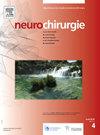马歇尔和鹿特丹量表作为严重创伤性脑损伤儿童死亡率预测指标的表现。
IF 1.4
4区 医学
Q4 CLINICAL NEUROLOGY
引用次数: 0
摘要
目的:创伤性脑损伤(TBI)是一个公共卫生问题,格拉斯哥昏迷量表(GCS)被认为是评估TBI严重程度的金标准工具,但在儿科人群中应用时可能低估了严重程度。GCS与脑CT扫描图像中建立的标准联合使用增强了预测该组患者预后的能力。马歇尔磅秤和鹿特丹磅秤是最常用的磅秤。本研究旨在评估和比较这些量表作为严重创伤性脑损伤儿童住院死亡率预测指标的表现。方法:采用儿童和青少年连续病历资料进行回顾性研究。结果:纳入研究的37例重度脑外伤儿童的受试者工作特征曲线下面积(AUC),马歇尔量表为0.65,鹿特丹量表为0.73,以住院死亡率为评价指标。在两种量表中,得分≥4分的儿童死亡率均较高,为42%(42%对12%;p = 0.05;或5.23;95% CI 0.9910 - 27.6872), 50%(50%对11%;p = 0.01;或8;95% CI 1.4247 - 44.9212)。结论:与马歇尔量表(AUC 0.65)相比,鹿特丹量表对重度脑外伤患儿住院死亡率的预测效果更好(AUC 0.73)。马歇尔量表和鹿特丹量表的截止点4在临床实践中可作为死亡率的预测指标,准确率分别为73%和78%。本文章由计算机程序翻译,如有差异,请以英文原文为准。
Performance of the Marshall and Rotterdam scales as predictors of mortality in children with severe traumatic brain injury
Objective
Traumatic brain injury (TBI) is a public health problem and the Glasgow Coma Scale (GCS) is recognized as the gold standard tool for grading TBI severity, but it may underestimate severity when applied in the pediatric population. The combined use of the GCS with criteria established in brain CT scan images enhances the ability to predict prognosis in this group of patients. The Marshall and Rotterdam scales are the most commonly used for this purpose. This study aims to evaluate and compare the performances of these scales as predictors of in-hospital mortality in children with severe TBI.
Methods
This was a retrospective study using data from consecutive medical records of children and adolescents (<17 years old) with severe TBI (GCS score ≤8) hospitalized between January 2016 and December 2023 at a Brazilian trauma reference center. Brain CT scan images were retrospectively analyzed for calculation of scores in the Marshall and Rotterdam scales. The cutoff score of 4 established as a predictor of prognosis was used to dichotomize the group. We calculated the performance and accuracy of both scales as predictors of prognosis.
Results
The area under the receiver operating characteristic curve (AUC) of the 37 children with severe TBI included in the study was 0.65 in the Marshall scale and 0.73 in the Rotterdam scale, considering in-hospital mortality as the outcome. In both scales the mortality rate was higher in children with scores ≥4, being 42% (42% vs. 12%; p = 0.05; OR 5.23; 95% CI 0.9910–27.6872) in the Marshall scale, and 50% (50% vs. 11%; p = 0.01; OR 8; 95% CI 1.4247–44.9212) in the Rotterdam scale.
Conclusion
The Rotterdam scale performed better as a predictor of in-hospital mortality (AUC 0.73) when compared to the Marshall scale (AUC 0.65) in the group of children with severe TBI analyzed. The cutoff point of 4 in the Marshall and Rotterdam scales can be used in clinical practice as a predictor of mortality with accuracy of 73% and 78% respectively.
求助全文
通过发布文献求助,成功后即可免费获取论文全文。
去求助
来源期刊

Neurochirurgie
医学-临床神经学
CiteScore
2.70
自引率
6.20%
发文量
100
审稿时长
29 days
期刊介绍:
Neurochirurgie publishes articles on treatment, teaching and research, neurosurgery training and the professional aspects of our discipline, and also the history and progress of neurosurgery. It focuses on pathologies of the head, spine and central and peripheral nervous systems and their vascularization. All aspects of the specialty are dealt with: trauma, tumor, degenerative disease, infection, vascular pathology, and radiosurgery, and pediatrics. Transversal studies are also welcome: neuroanatomy, neurophysiology, neurology, neuropediatrics, psychiatry, neuropsychology, physical medicine and neurologic rehabilitation, neuro-anesthesia, neurologic intensive care, neuroradiology, functional exploration, neuropathology, neuro-ophthalmology, otoneurology, maxillofacial surgery, neuro-endocrinology and spine surgery. Technical and methodological aspects are also taken onboard: diagnostic and therapeutic techniques, methods for assessing results, epidemiology, surgical, interventional and radiological techniques, simulations and pathophysiological hypotheses, and educational tools. The editorial board may refuse submissions that fail to meet the journal''s aims and scope; such studies will not be peer-reviewed, and the editor in chief will promptly inform the corresponding author, so as not to delay submission to a more suitable journal.
With a view to attracting an international audience of both readers and writers, Neurochirurgie especially welcomes articles in English, and gives priority to original studies. Other kinds of article - reviews, case reports, technical notes and meta-analyses - are equally published.
Every year, a special edition is dedicated to the topic selected by the French Society of Neurosurgery for its annual report.
 求助内容:
求助内容: 应助结果提醒方式:
应助结果提醒方式:


